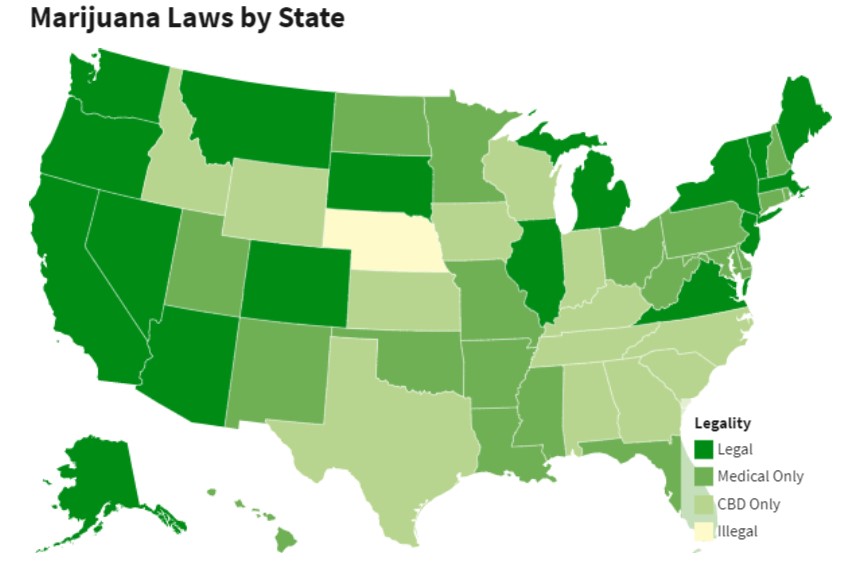What is MARIJUANA?
Marijuana is the dried, flowers, leaves,stems, and seeds of the Cannabis sativa plant. The chemical (THC) delta-9-tetrahydrocannabinol and several similar chemicals are found in the plant.
Introduction
It is the most widely farmed, trafficked, and used substance in the world; as the campaign for legalisation develops at home and internationally, marijuana is attracting substantial interest from investors, producers, and academics. Despite the fact that the plant is banned under national rules as a Schedule I substance, the legal marijuana sector in the United States was valued at $13.6 billion in 2019, with 340,000 employment devoted to plant handling, according to Frontier Data.
As of April 2021, 35 states along with the District of Columbia having legalised marijuana for medicinal purposes, with 16 allowing adults to consume the herb recreationally.
That figure may climb further if more individuals support the notion of legalizing’s marijuana across the US.
Changing Attitudes Towards Cannabis
Remember the 1930s film “Reefer Madness,” which was made to warn children and their parents about the dangers of marijuana? The film was designed to educate people, but it has since become a cult favorite and parody. People’s attitudes toward marijuana have shifted in tandem with their attitudes of the film.
This is particularly true as we understand more about the substance and the obvious advantages of utilizing it for medicinal purposes. It is still classified as a restricted drug under federal govt criteria after being classified as an unlawful substance. However, the image is being removed at a breakneck pace, and marijuana looks to be on its way to the public consciousness.

The Issue with Today’s High THC Marijuana from the Viewpoint of Addiction Psychiatrist
Advocates for the legalisation of medicinal and recreational marijuana are eager to point out all of the potential benefits that such a business could bring to a community. These include more jobs, more tax income, and potential medical advantages, and they sell it as “safe,” “healthy,” and “organic.” They use the terms “cannabis” and “marijuana” interchangeably without distinguishing between the many types of cannabis that have quite diverse effects on the brain and body.
The main issue with the present cannabis offered in Colorado dispensaries is the THC concentration is not what it used to be. It was lower than 2 percent before to the 1990s. It increased to 4% in the 1990s, and there was a 212 percent increase in THC level in marijuana flower between 1995 and 2015. In 2017, the most common strains identified in Colorado dispensaries had tetrahydrocannabinol (THC) levels ranging from 17-28%, as reported in the famous strain “Girl Scout Cookie.” 2 Unfortunately, these plants that produce high quantities of THC are unable to create much CBD, the plant’s defensive component, therefore these strains have very little CBD. Marijuana is by far the most commonly misused substance among eighth and twelfth graders, based on 2014 Monitoring the Future Study. 4 Marijuana usage among teens and those aged 18 to 25 has continuously increased in Colorado, far surpassing the national rate. Colorado tops the country in first-time marijuana use among individuals aged 12 to 17, with a 65% rise in teenage usage since legalization.
In Pakistan
ISLAMABAD: Shibli Faraz, has said that the country’s cannabis growing policy will be implemented by December of this year.
Sajid Mehdi presided over a meeting on Wednesday.
During the meeting, Minister stated that the global cannabis industry will reach Rs95 billion by 2025.
He also hinted at the imminent launch of a massive power-saving initiative and launched the Tech Tsunami Program, which would provide technological training to Pakistan’s young.
The science minister stated that the initiative will save 3,400 MW of electricity, which will be used to power home appliances.
According to Faraz, Pakistan uses a total of 24,000 MW of power, 16,000 MW of which is utilized just for cooling.
The federal minister told the committee that a litre of CBD oil is worth Rs10,000 when he briefed them on the cannabis cultivation initiative.
“Cannabis seeds will be grown near Rawat as well,” Faraz added.
The group was advised by officials that they would begin producing cannabis for industrial applications initially.
In the first stage, raw cannabis ingredients would be imported, and greenhouses will be constructed in Lahore, Karachi, and Islamabad. Shibli believes that an uncontrolled population is a threat to national security.
Officials also stated that cannabis oil trials have begun, and the Anti-Narcotics Agency has authorized four cannabis growth locations.
Committee Chairman Mehdi raised worry over the export of the ingredients used in cannabis cultivation. As a result, the science minister promised that rigorous regulations would be enacted to prevent raw material exports.
The group was advised by officials that they would begin producing cannabis for industrial applications initially.
In the first phase, cannabis raw materials would be imported, and greenhouses will be constructed in Lahore, Karachi, and Islamabad. He went on to say that high-tech technologies will be used in these facilities. Science Minister Faraz reminded the committee at the end of the discussion that the schools chosen for STEM program were chosen on merit.
“The STEM programs will be expanded to 450 schools, and the success of STEM schools will be reviewed,” he said, establishing the Technology Tsunami Program, which will provide training to Pakistan’s young.
“The software will assist in the resolution of ten significant challenges,” Faraz finished